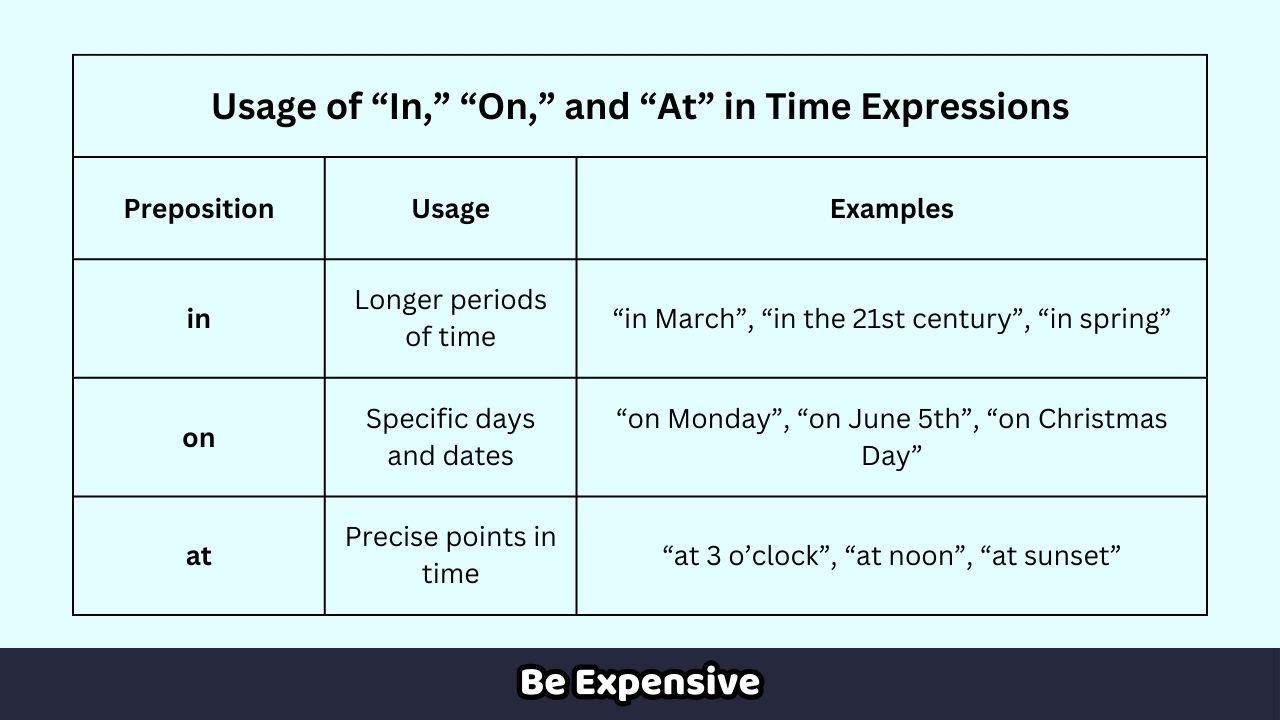Prepositions play a crucial role in the English language by indicating relationships between elements in a sentence, including time. Among the most commonly used prepositions to denote time are ‘in,’ ‘on,’ and ‘at.’
Time Prepositions: ‘In,’ ‘On,’ and ‘At’
Each of these prepositions has specific contexts where it is used to pinpoint different aspects of time: ‘in’ for longer periods, ‘on’ for specific days or dates, and ‘at’ for precise points in time. Mastering their usage not only enhances fluency but also ensures that your expressions of time are grammatically correct and contextually appropriate.
In this article, we share important information on the usage of ‘in,’ ‘on,’ and ‘at’ with comprehensive examples and explanations.
Preposition “In”: Usage with Longer Periods of Time and Seasons
The preposition “in” is primarily used to denote longer periods of time, such as months, years, centuries, and seasons. It establishes a relationship between an event or occurrence and the broader time frame within which it occurs.
1. Longer Periods of Time:
- Months: “She was born in January.” “They got married in November.”
- Years: “He started his career in 2005.” “The treaty was signed in 1789.”
- Centuries: “The Renaissance flourished in the 15th century.” “In the 20th century, technological advancements changed the world.”
2. Seasons:
- Summer: “We go swimming in summer.” “In summer, the days are longer.”
- Winter: “They enjoy skiing in winter.” “In winter, it often snows heavily.”
Preposition “On”: Usage with Specific Days and Dates
The preposition “on” is used to specify particular days of the week, specific dates, and certain holidays or events.
1. Specific Days:
- Days of the Week: “I have a meeting on Monday.” “We play football on Saturdays.”
- Weekends: “Let’s go hiking on the weekend.”
- Public Holidays: “The office is closed on Independence Day.”
2. Specific Dates:
- Dates: “Our anniversary is on April 5th.” “The concert is on June 15th.”
- Special Occasions: “We exchange gifts on Christmas Day.” “She always calls me on my birthday.”
- Annual Events: “The marathon is on New Year’s Day.”
Preposition “At”: Usage with Specific Points in Time and Times of the Day
The preposition “at” is used to pinpoint exact moments or specific points in time, including particular hours, minutes, and times of the day.
1. Specific Points in Time:
- Hours: “The meeting starts at 10 o’clock.” “They arrived at midnight.”
- Minutes: “The train departs at 3:15.” “I’ll call you back at 5:30.”
- Exact Times: “Dinner is served at 7:00.” “The movie starts at 8:45.”
2. Specific Times of the Day:
- Times of Day: “They wake up at sunrise.” “The party ends at dusk.”
- Specific Moments: “We met at noon.” “She always reads at bedtime.”
Expressions and Idioms: Using “In,” “On,” and “At”
In addition to their straightforward usage with specific time references, “in,” “on,” and “at” are also integral to various idiomatic expressions and phrases that convey nuances of time and timing.
1. “In” Idioms:
- In time: Refers to doing something with enough time to spare or before it’s too late. Example: “She arrived just in time for the meeting.”
- In the nick of time: Means just barely making it before the deadline or crucial moment. Example: “They finished the project in the nick of time.”
2. “On” Idioms:
- On time: Means punctually or at the scheduled time. Example: “Please be on time for the presentation.”
- On the dot: Refers to being exactly on time, often to the minute. Example: “The train arrives at 8:00 on the dot.”
3. “At” Idioms:
- At the moment: Indicates the current point in time or now. Example: “I’m busy at the moment, can I call you back later?”
- At the eleventh hour: Means at the last possible moment before it’s too late. Example: “They made a decision to invest at the eleventh hour.”
Comparative Usage of “In,” “On,” and “At” in Time Expressions
| Preposition | Usage | Examples |
|---|---|---|
| in | Longer periods of time | “in March”, “in the 21st century”, “in spring” |
| on | Specific days and dates | “on Monday”, “on June 5th”, “on Christmas Day” |
| at | Precise points in time | “at 3 o’clock”, “at noon”, “at sunset” |
Common Mistakes and Tips for Using “In,” “On,” and “At” with Time
Understanding the correct usage of “in,” “on,” and “at” in time expressions can be challenging for English learners. Here are some common mistakes and tips to help you master their usage:
Confusing “In,” “On,” and “At”:
- Mistake: Using “in” instead of “on” for specific days or dates (e.g., “in Monday”).
- Tip: Use “on” for specific days and dates (e.g., “on Monday,” “on June 5th”).
- Mistake: Using “at” instead of “in” for longer periods of time (e.g., “at March”).
- Tip: Use “in” for longer periods such as months, years, centuries, and seasons (e.g., “in March,” “in the 21st century”).
- Mistake: Using “on” instead of “at” for precise points in time (e.g., “on 3 o’clock”).
- Tip: Use “at” for specific times and moments (e.g., “at 3 o’clock,” “at noon”).
Tips for Mastery:
- Practice with Context: Use each preposition in sentences to understand their correct usage in different contexts. For example, create sentences that use “in” for longer periods, “on” for specific days and dates, and “at” for precise points in time.
- Visualize Time: Visual aids such as timelines or calendars can help reinforce the correct usage of prepositions with time expressions.
- Learn Idiomatic Expressions: Familiarize yourself with idiomatic expressions using “in,” “on,” and “at” related to time to understand their nuanced meanings (e.g., “in time,” “on time,” “at the moment”).
- Seek Feedback: Practice speaking and writing with native speakers or instructors who can provide feedback on your usage of prepositions with time.

